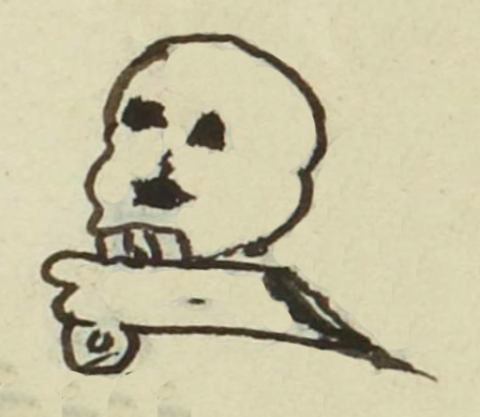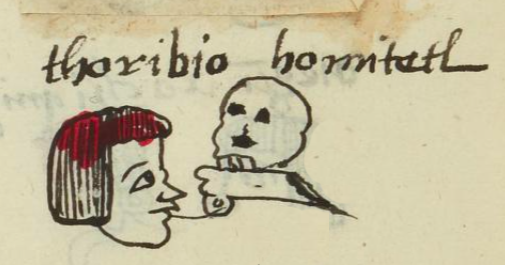Omitetl (MH550v)
This black-line drawing of the compound glyph for the personal name Omitetl (“Bone,” attested here as a man’s name) shows a skull and a horizontal piece of bone (omitl or omitetl). The bone is jagged on the right end and shows a knob of cartilage or epiphysis on the left end. The skull seems to be a semantic indicator to ensure the reading of bone for the piece below the skull. The word tetl (stone), may suggest a count of one, or it may suggest that the bone is hard. But tetl is not shown visually in the compound, unless the placement of the horizontal bone at the jaw of the skull is meant to call forth "tentli," a near homophone for tetl?
Stephanie Wood
Omitetl is a variant of omitl, according to Manuel Gamio, La población del valle de Teotihuacán (1922, 640), and the Vocabulario nahuatl-castellano de Acatlán, Guerrero (1995, 34). Omiteyo is another variation according to Laurencia Alvarez Heydenreich, La enfermedad y la cosmovisión en Hueyapan, Morelos (1987, 80). Note in the gloss the use of "th" for t and the intrusive "h." Such orthographic features are being tracked in this collection.
This Nahua name, Omitetl, is preceded in the gloss by a Christian first name (Toribio). He may have been named after Toribio de Benavente, also known as Motolinia ("One Who is Poor or Afflicted"). This was the first word he learned in Nahuatl, and he went on to learn the language well. He lived in the monastery in Huejotzingo. Doing a quick search for the name "Toribio" will produce an impressive result.
Stephanie Wood
thoribio homitetl
Toribio Omitetl
Stephanie Wood
1560
huesos, cráneos, hueso

omi(tl), bones, https://nahuatl.wired-humanities.org/content/omitl
te(tl), stone or counter, https://nahuatl.wired-humanities.org/content/tetl-0
El Hueso
Stephanie Wood
Matrícula de Huexotzinco, folio 550v, World Digital Library, https://www.loc.gov/resource/gdcwdl.wdl_15282/?sp=180.
This manuscript is hosted by the Library of Congress and the World Digital Library; used here with the Creative Commons, “Attribution-NonCommercial-ShareAlike 3.0 License” (CC-BY-NC-SAq 3.0).






